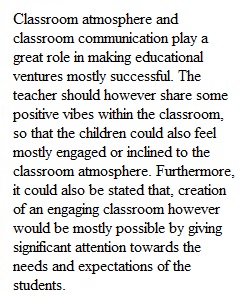


Q Assignment Instructions Instructions Submission of your graded assignment is due by 11:59 p.m. Central time on Sunday. Assignments should be created and submitted as an attachment in one of the following forms: (MS Word or PDF) as AssignmentTitle_LastnameFirstInitial.docx or .pdf. View the general instructions below for assignment requirements, formatting expectations, and grading rubric applied to all CM Assignments. This information can also be found in the General Instructions for Classroom Management Assignments Specific Instructions for Module 3 CM Assignment, which is based on Chapters 6 & 4 Chapter 6: Teacher–Communication Skills for Teaching After reading Chapter 6, use what you have learned from the chapter to answer the prompt questions below. Chapter 6 Details: Communication is one of the most important things we do in a classroom. Many times we communicate with students (and others) in ways that make life harder for us as teachers and our students, so it is necessary to reflect on the words and body language you use as a teacher. Chapter 6 focuses on four areas of communication: limits (firm and soft), supportive language, listening, and nonverbal communication. 1. Describe soft limits and explain why you should not use them. 2. Describe firm limits and explain why you should use them. 3. Describe the four types of supportive language (pp. 103–105). 4. Explain how you can be an active listener and why it is important. 5. Describe proxemics and kinesics in nonverbal communication (middle of p. 108). Also explain why it is important that the words that come out of your mouth match your kinesics. 6. Identify at least one way you will use each of the six Nonverbal Communication Methods Teachers Use (pp. 108–109). Chapter 4: Choosing Rules and Procedures After reading Chapter 4, use what you have learned from the chapter to answer the prompt questions below. Chapter 4 Details: After reading Chapter 4, respond to the following: 1. Use the rules for rules (specifically Table 4.1, #3–7 on p. 66) to create a list of your classroom rules. Please remember that rules are designed to provide guidelines for behavior, not for attitudes or emotions (those are expectations, not rules). Remember also that rules must be enforceable. (Consider how you would enforce the rule “Everyone must be happy” when a student whose dog was run over by the school bus that morning comes to class.) Think long and hard about these because they need to be appropriate for the age of your students. 2. For each rule, provide two examples of behaviors which will break that rule. 3. Using the information in Table 4.3 (pp. 72–73), identify and describe 10 specific classroom procedures you will use regularly. Even if you plan to become a secondary teacher, you should have numerous classroom procedures to make the use of class time more efficient and effective. 4. Table 4.2 lists nine guidelines for teaching/reviewing rules—these also work for procedures. Recognizing that very few people remember or understand anything they have been told the first time (or second to tenth time depending on the student), identify at least five of the guidelines you think you will use and why those will be developmentally appropriate for the grade level you plan to teach. (By the way, if you simply accept the fact that the vast majority of students (people in general) must be told or shown things at least two to three times before they even begin to remember, you will save yourself a great deal of stress.) 5. Finally, the last section of the chapter is about helping students assume responsibility for their behavior. This is something you really want to help your students learn because the more they take responsibility for their behavior, the less you will have to do it (it’s a control thing from Chapter 2). Identify how you can use each of the three main categories in your classroom and why it will benefit students in the long term. ________________________________________ Reminder every CM Assignment needs to have an introduction, body (response to question prompts for both chapters), conclusion (summary of both chapters if two chapters are assigned), and reference page (adhere to APA 7th Style). Do not use direct quotes, paraphrase only! Estimated time for completion: 10 hours for reading and writing reflection
View Related Questions